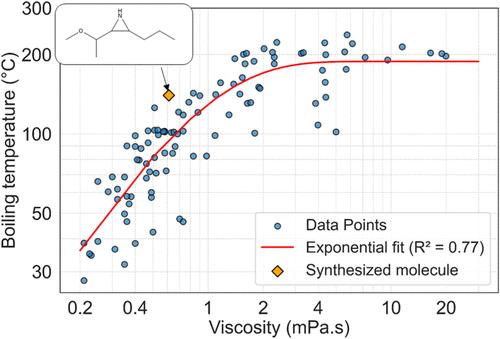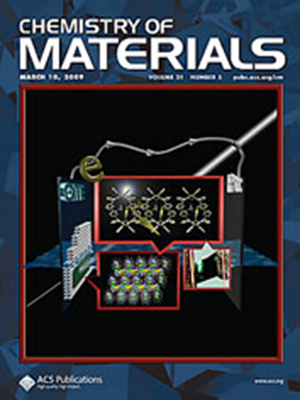Exploring Molecules with Low Viscosity: Using Physics-Based Simulations and De Novo Design by Applying Reinforcement Learning
IF 7.2
2区 材料科学
Q2 CHEMISTRY, PHYSICAL
引用次数: 0
Abstract
Molecules with viscosities lower than those of conventional organic solvents are highly sought after for applications in electrochemical devices such as batteries and capacitors. These molecules improve the electrical resistance of devices, enhancing their efficiency, especially at low temperatures. To identify new molecules with low viscosities, we conducted extensive molecular dynamics (MD) simulations on 10,000 molecules selected from the GDB-17 chemical structure database, specifically choosing molecules with fewer than 12 heavy atoms. Additionally, we performed density functional theory (DFT) calculations to determine the energies of the highest occupied molecular orbitals (HOMO) of these molecules as a surrogate for the oxidation potential. We used the data on viscosity and HOMO levels as training sets to develop machine-learning models that predict these properties. Using these models, we carried out molecular de novo design using the REINVENT method, a reinforcement-learning approach utilizing SMILES strings. This method aimed to identify molecules that minimize viscosity while maintaining sufficiently low HOMO levels for stability. The approach successfully identified new chemical structures with viscosities below 2 mPa·s and suitably low HOMO energies. We synthesized a novel compound from the top candidates and validated our predictions experimentally. The experimental results closely matched our predictions, demonstrating that combining physics-based simulations with reinforcement learning is an effective strategy for designing novel molecules with targeted properties.

探索低粘度分子:通过强化学习使用基于物理的模拟和新设计
粘度低于传统有机溶剂的分子在电池和电容器等电化学设备中的应用备受青睐。这些分子可改善设备的电阻,提高其效率,尤其是在低温条件下。为了找出具有低粘度的新分子,我们对从 GDB-17 化学结构数据库中选出的 10,000 个分子进行了广泛的分子动力学(MD)模拟,特别选择了重原子数少于 12 个的分子。此外,我们还进行了密度泛函理论 (DFT) 计算,以确定这些分子的最高占位分子轨道 (HOMO) 的能量,作为氧化势的替代。我们利用粘度和 HOMO 水平数据作为训练集,开发了预测这些特性的机器学习模型。利用这些模型,我们使用 REINVENT 方法(一种利用 SMILES 字符串的强化学习方法)进行了分子从头设计。这种方法旨在找出既能最大限度降低粘度,又能保持足够低的 HOMO 水平以确保稳定性的分子。该方法成功地确定了粘度低于 2 mPa-s、HOMO 能量适当低的新化学结构。我们从最佳候选化合物中合成了一种新型化合物,并通过实验验证了我们的预测。实验结果与我们的预测非常吻合,这表明将基于物理的模拟与强化学习相结合是设计具有目标特性的新型分子的有效策略。
本文章由计算机程序翻译,如有差异,请以英文原文为准。
求助全文
约1分钟内获得全文
求助全文
来源期刊

Chemistry of Materials
工程技术-材料科学:综合
CiteScore
14.10
自引率
5.80%
发文量
929
审稿时长
1.5 months
期刊介绍:
The journal Chemistry of Materials focuses on publishing original research at the intersection of materials science and chemistry. The studies published in the journal involve chemistry as a prominent component and explore topics such as the design, synthesis, characterization, processing, understanding, and application of functional or potentially functional materials. The journal covers various areas of interest, including inorganic and organic solid-state chemistry, nanomaterials, biomaterials, thin films and polymers, and composite/hybrid materials. The journal particularly seeks papers that highlight the creation or development of innovative materials with novel optical, electrical, magnetic, catalytic, or mechanical properties. It is essential that manuscripts on these topics have a primary focus on the chemistry of materials and represent a significant advancement compared to prior research. Before external reviews are sought, submitted manuscripts undergo a review process by a minimum of two editors to ensure their appropriateness for the journal and the presence of sufficient evidence of a significant advance that will be of broad interest to the materials chemistry community.
 求助内容:
求助内容: 应助结果提醒方式:
应助结果提醒方式:


